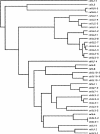A novel family of C. elegans snRNPs contains proteins associated with trans-splicing
- PMID: 17283210
- PMCID: PMC1831854
- DOI: 10.1261/rna.426707
A novel family of C. elegans snRNPs contains proteins associated with trans-splicing
Abstract
In many Caenorhabditis elegans pre-mRNAs, the RNA sequence between the 5' cap and the first 3' splice site is replaced by trans-splicing a short spliced leader (SL) from the Sm snRNP, SL1. C. elegans also utilizes a similar Sm snRNP, SL2, to trans-splice at sites between genes in polycistronic pre-mRNAs from operons. How do SL1 and SL2 snRNPs function in different contexts? Here we show that the SL1 snRNP contains a complex of SL75p and SL21p, which are homologs of novel proteins previously reported in the Ascaris SL snRNP. Interestingly, we show that the SL2 snRNP does not contain these proteins. However, SL75p and SL26p, a paralog of SL21p, are components of another Sm snRNP that contains a novel snRNA species, Sm Y. Knockdown of SL75p is lethal. However, knockdown of either SL21p or SL26p alone leads to cold-sensitive sterility, whereas knockdown of both SL21p and SL26p is lethal. This suggests that these two proteins have overlapping functions even though they are associated with different classes of snRNP. These phenotypic relationships, along with the association of SL26p with SL75p, imply that, like the SL1 RNA/Sm/SL75p/SL21p complex, the Sm Y/Sm/SL75p/SL26p complex is associated with trans-splicing.
Figures







Similar articles
-
Trans-splicing and operons in C. elegans.WormBook. 2012 Nov 20:1-11. doi: 10.1895/wormbook.1.5.2. WormBook. 2012. PMID: 23175478 Free PMC article. Review.
-
A complex containing CstF-64 and the SL2 snRNP connects mRNA 3' end formation and trans-splicing in C. elegans operons.Genes Dev. 2001 Oct 1;15(19):2562-71. doi: 10.1101/gad.920501. Genes Dev. 2001. PMID: 11581161 Free PMC article.
-
trans splicing of polycistronic Caenorhabditis elegans pre-mRNAs: analysis of the SL2 RNA.Mol Cell Biol. 2000 Sep;20(18):6659-67. doi: 10.1128/MCB.20.18.6659-6667.2000. Mol Cell Biol. 2000. PMID: 10958663 Free PMC article.
-
The SL1 trans-spliced leader RNA performs an essential embryonic function in Caenorhabditis elegans that can also be supplied by SL2 RNA.Genes Dev. 1996 Jun 15;10(12):1543-56. doi: 10.1101/gad.10.12.1543. Genes Dev. 1996. PMID: 8666237
-
Trans-splicing and operons.WormBook. 2005 Jun 25:1-9. doi: 10.1895/wormbook.1.5.1. WormBook. 2005. PMID: 18050426 Review.
Cited by
-
A novel, essential trans-splicing protein connects the nematode SL1 snRNP to the CBC-ARS2 complex.Nucleic Acids Res. 2022 Jul 22;50(13):7591-7607. doi: 10.1093/nar/gkac534. Nucleic Acids Res. 2022. PMID: 35736244 Free PMC article.
-
GEI-8, a homologue of vertebrate nuclear receptor corepressor NCoR/SMRT, regulates gonad development and neuronal functions in Caenorhabditis elegans.PLoS One. 2013;8(3):e58462. doi: 10.1371/journal.pone.0058462. Epub 2013 Mar 6. PLoS One. 2013. PMID: 23484030 Free PMC article.
-
Trans-splicing and operons in C. elegans.WormBook. 2012 Nov 20:1-11. doi: 10.1895/wormbook.1.5.2. WormBook. 2012. PMID: 23175478 Free PMC article. Review.
-
A differential sequencing-based analysis of the C. elegans noncoding transcriptome.RNA. 2012 Apr;18(4):626-39. doi: 10.1261/rna.030965.111. Epub 2012 Feb 16. RNA. 2012. PMID: 22345127 Free PMC article.
-
A polypyrimidine tract binding protein, pumpkin RBP50, forms the basis of a phloem-mobile ribonucleoprotein complex.Plant Cell. 2009 Jan;21(1):197-215. doi: 10.1105/tpc.108.061317. Epub 2009 Jan 2. Plant Cell. 2009. PMID: 19122103 Free PMC article.
References
-
- Blaxter, M., Liu, L. Nematode spliced leaders—Ubiquity, evolution, and utility. Int. J. Parasitol. 1996;26:1025–1033. - PubMed
-
- Blumenthal, T. Trans-splicing and operons. 2005. In Wormbook (ed. The C. elegans Research Community) Wormbook, doi/10.1895/wormbook.1.5.1, http://www.wormbook.org. - PubMed
-
- Blumenthal, T., Spieth, J. Gene structure and organization in Caenorhabditis elegans . Curr. Opin. Genet. Dev. 1996;6:692–698. - PubMed
-
- Bruzik, J.P., Van Doren, K., Hirsh, D., Steitz, J.A. Trans splicing involves a novel form of small nuclear ribonucleoprotein particles. Nature. 1988;335:559–562. - PubMed
Publication types
MeSH terms
Substances
Grants and funding
LinkOut - more resources
Full Text Sources
Miscellaneous
